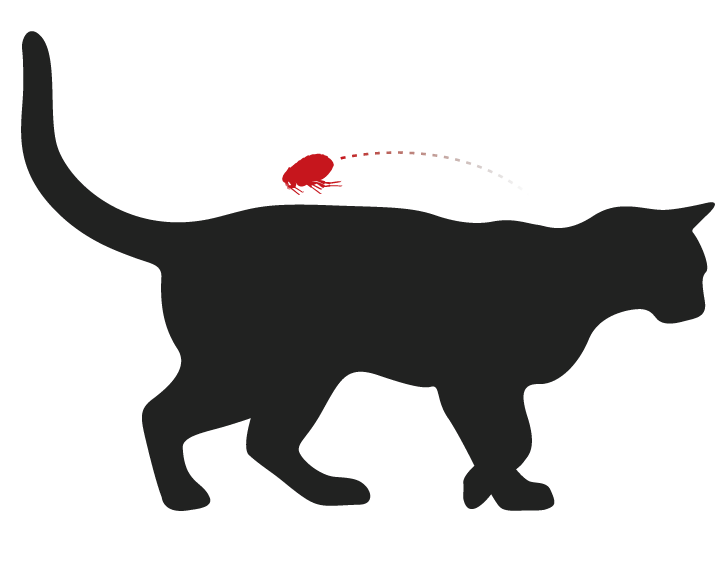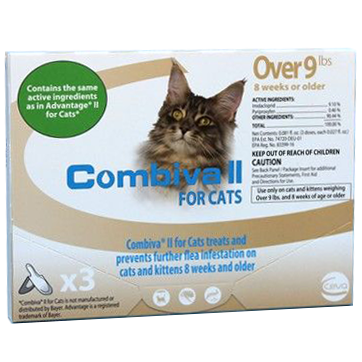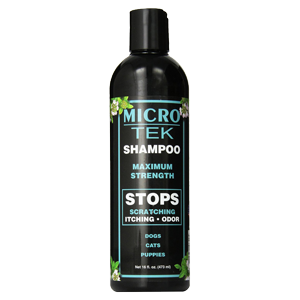
Adult fleas live on their host, rarely leaving. Infested cats are constantly being bit. Relieving pet discomfort is the first priority when battling fleas. Topical flea drops provide immediate and lasting control.
Supplies
Cats & the Flea Life Cycle
Flea Life Cycle & Habitats
Adult fleas stay on their host as permanent residents. There, they feed, mate, and lay eggs. The eggs aren’t sticky and drop from a cat’s fur within a few hours of being laid. In the environment, the eggs transition into larvae, pupae, and ultimately new adults. Flea populations break down into 50-57% eggs, 34-35% larvae, 8-10% pupae, and 1-5% adults.
Flea eggs become adults in 17-26 days. However, once mature, an adult may enter into a quiescent (sleep) state within its cocoon. This dormant-like state can last up to 5 months. So, while most fleas emerge within a month, lower numbers may pop up well into the future.
Killing Existing Adult Fleas isn’t Enough
It’s important to treat cats with a product designed for long-term control. An infestation won’t end by only targeting existing adult fleas. 95-99% of the population is composed of pre-adult stages residing in the environment (usually carpeting). New adults will continue to emerge for months to re-infest pets. Females will feed, mate, and start laying eggs in two days, at a rate of 25 eggs a day. The infestation will continue.
Flea Drops for Cats
Long-term Control
Flea drops are a long-lasting, effective way to get rid of fleas on cats. Existing adult fleas are quickly killed, and new fleas that jump onto the treated cat will be killed. Re-application is only needed once per month. Treatments are typically continued for 3-4 months, ensuring the entire infestation is eradicated to prevent re-infestation. Year-round or seasonal control are also options with flea drops.
Dual-Action
Most flea drops available today are dual-action. They contain two types of active ingredients: an adulticide which kills adult fleas, and an insect growth regulator (IGR) which inhibits immature stages and sterilizes adult females.
Common adulticides found in flea drops are imidacloprid or fipronil. The adulticide rapidly kills existing adult fleas, relieving the cat from its flea burden and new bites. Residual activity lasts for 30 days. Any new fleas that jump onto the cat will die before they have a chance to reproduce.
Common IGRs in flea drops are methoprene (Precor) or pyriproxyfen (Nylar). IGR-exposed female adults are sterilized, so they can’t lay viable eggs even if they survived the adulticide. In addition, exposed eggs and larvae are unable to develop and reach maturity.
Insecticides are rarely 100% effective. By combining adulticides and IGRs, efficacy is increased by adding redundancy to fills in the gaps. This ensures that fleas can’t reproduce. Without a new generation, eventually the entire population will go extinct.
Flea drops alone can end mild to moderate infestations, especially for indoor cats. However, treating and sanitizing the environment is also recommended to add redundancy and speed up the eradication process (see steps 3-5 in integrated flea control).
Popular Flea Drops for Cats
Tips for Success
Don’t Quarantine Treated Cats
Allow properly treated cats to roam free. They’ll return to their favorite resting spots, which will also be flea hotbeds. Newly emerging fleas will jump onto the treated cats and die. Also, heat and pressure (e.g. when a cat lays down) will force pre-emerged adults to wake up, emerge, and then die. This will help speed up the eradication of fleas on the premises.
Some of the insecticide will rub off of the cat and into the environment. Environmental transfer usually occurs where cats groom and rest. Again, these areas are flea hot-spots. The residual insecticide left in the environment will help kill or inhibit the fleas living there.
Be Patient
Fleas don’t always die immediately when exposed to insecticides. It may take several hours, and up to 36 hours. When a cat enters a flea hot-spot, many new fleas will be seen on the cat. However, they should be small, unfed fleas in the process of succumbing to the insecticide. The fleas will ultimately die if the cat was properly treated.
It typically takes at least 8 weeks before an infestation is completely over. All of the environmental stages must mature, emerge, and die.
Only Use Products Labeled for Cats
Only treat cats with flea drops (or other products) that are specifically labeled for use on cats. Dogs and cats tolerate different insecticides, and products are formulated for specific animals of specific weights. For example, permethrin is sometimes included in flea products for dogs, but this compound is highly toxic and potentially lethal to cats.
Other Tips
- Treat all pets in the home, even those without fleas.
- Apply the correct dosage of drops. Don’t split treatments between cats.
- Apply drops to the cat’s skin, not fur.
- Apply drops when the cat is dry.
- Don’t allow a lapse in treatment.
- Don’t stop treatment early, even during winter.
- After treatment, don’t immerse cats in water more than once weekly.
- Don’t switch products. Reserve this as a last resort.
- Oral treatments may be a better option for cats with a skin disease.
- Only treat cats with products labeled specifically for use on cats.
For more details on these tips, please visit our page on Why Flea Control Fails
Optional Soothing shampoo
Bathing cats with a soothing, anti-itch shampoo can help alleviate existing flea bites. If shampooing is done prior to applying flea drops, allow cats to thoroughly dry before administering treatments. If shampooing is done after applying flea drops, wait at least four days after treating the cat.
There are a variety of flea control shampoos available. While they may kill existing fleas on cats, they rarely offer long-term control. Monthly flea drops are typically still needed.




You must log in to post a comment. Log in now.